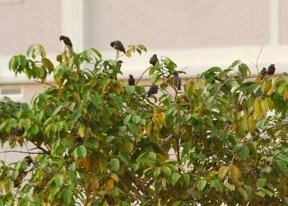 The Javan Myna (Acridotheres javanicus) is a rather interesting bird despite it being an exotic species. But we must all agree that there is still a lot that we do not know of this bird, however frequent it is sighted. See also earlier post.
The Javan Myna (Acridotheres javanicus) is a rather interesting bird despite it being an exotic species. But we must all agree that there is still a lot that we do not know of this bird, however frequent it is sighted. See also earlier post.
Back down the years, my father saw gangs of these mynas fighting. Each group comprised of up to 20 individuals. The fight was even more peculiar. Two birds would clasp their claws together and engaged in a frenzy of beating wing and wild pecking. My father had personally seen them so engrossed with their fight that a passing van made roadkill of them.
“Gang fights” were often to the death. These were one-on-one battles where each member of a gang took on another from the other gang, instead of a wild 4-5 mobbing a single bird. And only one myna of the fighting pair walked away alive.
I myself have seen milder versions of such fights. It involved small leaps, accompanied by flapping of wings to prolong time in the air, and a brandishing of claws. This was usually enough to send a weaker opponent away. I have seen this in foraging mynas. One individual, probably a misfit, was constantly chased away by one individual of a group. Usually, the myna that was chased away picked another foraging spot.
From all this, it is easy to conclude that they have very complex social behaviour. And if so, how do they find mates? I have read that a myna mates for life, one reason why most of them forage in pairs. But if so, would a gang have an even number of individuals, made up of many of such pairs? Or would it comprise separate individuals with no sexual relationship to the others?
Territorial behaviour of mynas is of course more than just fights, there could be some kind of warning first. I often see the birds performing a kind of head movement. The myna would ruffle up its feathers (probably to make itself look bigger to opponents), and start bobbing its head up and down, which is sometimes accompanied by a shrill or a single call that is repeated. I have no idea if this is territorial behaviour, because I have also observed mynas that became violent without prior warning. Worse still, whenever I spot a myna performing the “head-bob”, I rarely see any other mynas around.
I also start to wonder whether only the male does it. I observed one of a myna pair near the edge of the road performing the “head-bob”. After it was done, the other myna beside it started to do the same. If it was a pair of one male and one female (life mates), then I can be sure that both sexes perform it and territory (if it was territorial in the first place) was “held on” by both members of the pair.
Can anyone shed some light to the above?
Contributed by Lim Jun Ying, a young birder with an inquiring mind
Comments by our bird specialist, R. Subaraj: Gang fights by Javan Mynas can indeed be pretty vicious and they are oblivious to nearly everything around when they are engaged in battle. Fights are often between separate packs, two pairs or sometimes, they seem to attack one particular individual. After it is over, it is not uncommon to find feathers everywhere and sometimes a wing as well. As for the headbobbing and ruffling of head feathers, here is a subject for study to determine the actual reasons behind it. It certainly looks like irritation and I have observed mynas ruffling their head feathers and muttering in their own language at me!









3 Responses
No answers to the questions. It might be typical mynah social behaviour, or perhaps a response (?) to overcrowding and intensified competition for food and territory. In the evenings though, the birds tend to gather in large loose flocks in open areas prior to their communal tree roosts.
Konrad Lorenz in King Solomon’s Ring offers a detailed discussion of jackdaw social structures, signals and communication. Perhaps a good birder could draw out similar observations for mynahs too.
a sign of irritation? that’s interesting. That could explain why both sexes apparently show such behaviour, and the fact that i observe it even in the absence of other mynas.
I saw an interesting example of Myna battles the other morning. Apologies that the video isn’t excellent, but I only had my phone handy. The video is on youtube:
http://www.youtube.com/watch?v=22WTR3X6MbY